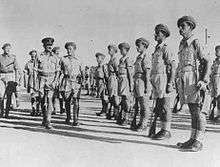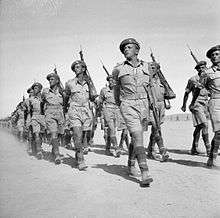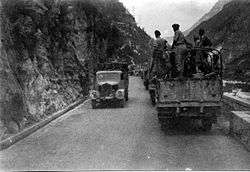Jewish Brigade
| Jewish Brigade | |
|---|---|
|
Insignia and sleeve patch of the Jewish Brigade | |
| Active | 1944–1946 |
| Country |
|
| Branch |
|
| Type | Infantry |
| Size | Brigade group, 5,000 volunteers |
| Commanders | |
| Notable commanders | Ernest Benjamin |
The Jewish Infantry Brigade Group,[1] more commonly known as the Jewish Brigade Group[2] or Jewish Brigade,[3] was a military formation of the British Army composed of Jews from the Yishuv in Mandatory Palestine commanded by British-Jewish officers that served in Europe during World War II. The brigade was formed in late 1944,[1][2] and its personnel fought the Germans in Italy. After the war, some of them assisted Holocaust survivors to emigrate illegally to Mandatory Palestine as part of Aliyah Bet.[4][5]
Background

After World War I, the British Empire and the French empire replaced the Ottoman Empire as the pre-eminent powers in the Middle East. This change brought closer the Zionist movement's goal of creating a Jewish state. The Balfour Declaration of 1917 signified the first official approval of this proposal, and led to a surge of Jewish emigration in 1918–1921, known as the "Third Aliyah".[6] The League of Nations incorporated the Declaration in the British Mandate for Palestine in 1922. Jewish immigration continued through the 1920s and 1930s, and the Jewish population expanded by over 400,000 before the beginning of the Second World War.[6]

However, in the White Paper of 1939, the British government under Neville Chamberlain abandoned the idea of establishing a Jewish Commonwealth. When the Second World War began in September 1939, David Ben-Gurion, the head of the Jewish Agency, famously declared: "We will fight the White Paper as if there is no war, and fight the war as if there is no White Paper."[7]
Chaim Weizmann, the President of the World Zionist Organization, offered the British government full cooperation of the Jewish community in Mandatory Palestine. Weizmann sought to establish an identifiably Jewish fighting formation (under a Jewish flag) under the auspices of the British Army. His request for a separate formation was rejected, but many Jews in Mandatory Palestine wanted to fight the Nazis and joined the British Army. Some of these were formed into separate Jewish companies in their battalions. There was a Jewish battalion attached to the British Army’s East Kent Regiment stationed in Mandatory Palestine.[5]
In all, fifteen Palestinian Jewish battalions were formed in the British Army in September 1940, and fought in the Greek campaign of 1941.
But there was no designated all-Jewish formation. Jewish groups petitioned the British government to create such a force, but the British refused.[8] At that time, the White Paper was in effect, limiting Jewish immigration and land purchases.[5]
Some British officials opposed creating a Jewish fighting force, fearing that it could become the basis for Jewish rebellion against British rule.[5] In August 1944, Winston Churchill finally agreed to the formation of a "Jewish Brigade". According to Rafael Medoff, Churchill consented because he was "moved by the slaughter of Hungarian Jewry [and] was hoping to impress American public opinion."[8]
Formation of the Jewish Brigade

After early reports of the Nazi atrocities of the Holocaust were made public by the Allied powers, the Prime Minister Winston Churchill sent a personal telegram to the US President Franklin D. Roosevelt suggesting that "the Jews... of all races have the right to strike at the Germans as a recognizable body." The president replied five days later saying: "I perceive no objection..."
After much hesitation, on July 3, 1944, the British government consented to the establishment of a Jewish Brigade with hand-picked Jewish and also non-Jewish senior officers. On 20 September 1944 an official communique by the War Office announced the formation of the Jewish Brigade Group of the British Army and the Jewish Brigade Group headquarters was established in Egypt at the end of September 1944 (the formation was styled a brigade group because of the inclusion under command of an artillery regiment). The Zionist flag was officially approved as its standard. It included more than 5,000 Jewish volunteers from Mandatory Palestine organized into three infantry battalions of the Palestine Regiment and several supporting units.
- 1st Battalion, Palestine Regiment
- 2nd Battalion, Palestine Regiment
- 3rd Battalion, Palestine Regiment
- 200th Field Regiment (Royal Artillery)
The New York Times dismissed it as a "token" while The Manchester Guardian lamented "The announcement that a Jewish Brigade will fight with the British Army is welcome, if five years late. Once regrets that the British Government has been so slow to seize a great opportunity."
World War II



In October 1944, under the leadership of Brigadier Ernest F. Benjamin, the brigade group was shipped to Italy and joined British Eighth Army in November which was engaged in the Italian Campaign under 15th Army Group.[5][9]

The brigade group took part in the Spring Offensive of 1945. It took positions on the front line in the Alfonsine sector, and was soon engaged in combat. On March 19–20, 1945, it initiated two attacks. The brigade then moved to the Senio River sector, where it fought against the German 4th Parachute Division commanded by Generalleutnant Heinrich Trettner. On April 9, the brigade crossed the river and established a bridgehead, widening it the following day.[10] In addition, they were represented among the liberating Allied units at a Papal audience. The Jewish Brigade was then stationed in Tarvisio, near the border triangle of Italy, Yugoslavia, and Austria. They searched for Holocaust survivors, provided survivors with aid, and assisted in their immigration to Palestine.[5] They played a key role in the Berihah's efforts to help Jews escape Europe for British Mandatory Palestine, a role many of its members were to continue after the Brigade disbanded. Among its projects was the education and care of the Selvino children. In July 1945, the Brigade moved[9] to Belgium and the Netherlands.
Overall, in the course of World War II, the Jewish Brigade's casualties were 83 killed in action or died of wounds and 200 wounded. [11]Another 78 of the brigade's soldiers were mentioned in dispatches, and 20 received military decorations (7 Military Medals, 7 Order of the British Empire medals, 4 Military Crosses, and 2 US awards).[12]
Post-War
Tilhas Tizig Gesheften (commonly known by its initials TTG, loosely translated as "kiss [literally, lick] my arse business") was the name of a group of Jewish Brigade members formed immediately following the Second World War. Under the guise of British military activity, this group engaged in the assassination of Nazis, facilitated the illegal immigration of Holocaust survivors to Mandatory Palestine, and smuggled weaponry to the Haganah.[5]
The Jewish Brigade also joined groups of Holocaust survivors in forming assassination squads known as the Nokmim for the purpose of tracking down and killing former SS and Wehrmacht officers who had participated in atrocities against European Jews. Information regarding the whereabouts of these fugitives was gathered either by torturing imprisoned Nazis or by way of military connections. The British uniforms, military documentation, equipment, and vehicles used by Jewish Brigade veterans greatly contributed to the success of the Nokmim. The number of Nazis the Nokmim killed is unknown, but may have been as high as 1,500.[13][14][15]
After assignment to the VIII Corps District of the British Army of the Rhine (Schleswig-Holstein), the Jewish Brigade was disbanded in the summer of 1946.[16]
Involvement in the Bricha
Many members of the Jewish Brigade assisted and encouraged the implementation of the Bricha. In the vital, chaotic months immediately before and after the German surrender, members of the Jewish Brigade supplied British Army uniforms and documents to Jewish civilians who were facilitating the illegal immigration of Holocaust survivors to Mandatory Palestine. The most notable example was Yehuda Arazi, code name "Alon," who had been wanted for two years by the British authorities in Palestine for stealing rifles from the British police and giving them to the Haganah. In 1945, Arazi and his partner Yitzhak Levy travelled from Mandatory Palestine to Egypt by train, dressed as sergeants from the Royal Engineers. From Egypt, the pair travelled though North Africa to Italy and, using false names, joined the Jewish Brigade, where Arazi secretly became responsible for organising illegal immigration. This included purchasing boats, establishing hachsharot, supplying food and compiling lists of survivors.[17]
When Arazi reached the Jewish Brigade in Tarvisio in June 1945, he informed some of the Haganah members serving in the Brigade that other units had made contact with Jewish survivors. Arazi impressed upon the Brigade their importance in Europe and urged the soldiers to find 5,000 Jewish survivors to bring to Mandatory Palestine.[18] Jewish Brigade Officer Aharon Hoter-Yishai recalled that he doubted the existence of 5,000 Jewish survivors; regardless, the Jewish Brigade accepted Arazi's challenge without question. For many Jewish soldiers, this new mission justified their previous service in the British forces that had preceded the creation of the Jewish Brigade.[19]
Another Jewish Brigade soldier actively involved in the Berihah was Israel Carmi, who was discharged from the Jewish Brigade in the autumn of 1945. After a few months, the Secretariat of Kibbutz HaMeuchad approached Carmi about returning to Europe to assist with the Berihah. Carmi’s previous experience working with survivors made him an important asset for the Berihah movement. He returned to Italy in 1946 and attended the 22nd Zionist Congress in Basel, where he gained insight into how the Berihah operated throughout Europe. Carmi proposed establishing a second Berihah route across Europe in the event that the existing route collapsed. In addition, he also proposed dividing the Berihah leadership into parts: Mordechai Surkis, working from Paris, would be responsible for the financial workings; Ephraim Dekel in Prague would run the administrative element, and oversee the Berihah in Poland, Czechoslovakia and Germany; and Carmi, working from Prague, would oversee activities in Hungary, Yugoslavia and Romania.[20]
Jewish Brigade soldiers, assisting with the Berihah, specifically took advantage of the chaotic situation in post-war Europe to move Holocaust survivors between countries and across borders. Soldiers were intentionally placed by Merkaz Lagolah at transfer points and border crossings to assist the Jewish DPs (displaced persons).[21] For example, Judenberg, a sub-camp of the Mauthausen concentration camp, acted as a Berihah point where Brigade soldiers and partisans worked together to assist DPs. Similarly, in the city of Graz, a Berihah point was centred in a hotel where a legendary Berihah figure, Pinchas Zeitag, also known as Pini the Red or “Gingi,” organised transports westwards to Italy.[22] One of the Jewish Brigade's greatest contributions to the Berihah was the use of their British Army vehicles to transport survivors (up to a thousand people at a time) in truck convoys to Pontebba, the brigade's motor depot. These secret transports generally arrived at 2 or 3 a.m., and the Brigade always ensured that DPs were greeted by a soldier or an officer and welcomed into a dining hall with food and tea. Everyone was given a medical examination, a place to sleep, and clean clothing; and within a few days the group was moved to hachsharot in Bari, Bologna and Modena. After recuperating and completing their hachshara training, the DPs were taken to ports where boats would illegally set sail for Mandatory Palestine.[23] Historians estimate that the Jewish Brigade assisted in the transfer, between 1945 and 1948, of 15,000 - 22,000 Jewish DPs as part of the Berihah and the illegal immigration movement.[24]
Military Legacy
In 1948, after the Israeli Declaration of Independence, many Jewish Brigade veterans served with distinction in the Israel Defense Forces during the Israeli War of Independence. Many veterans would serve as high-ranking officers in the Israeli military, 35 becoming generals.[25][26]
Legacy
The Jewish Brigade inspired numerous books[27] and films.[28] In 1998, filmmakers Chuck Olin (Director) and Matthew Palm (Co-Producer) released their award-winning documentary, In Our Own Hands. The film aired on PBS in the United States, and played in numerous film festivals around the world.
In Popular Culture
In Leon Uris novel Exodus, and the subsequent film, protagonist Ari Ben Canaan of the Haganah succeeds in organising the movement of refugees to Palestine, through his experience of action and use of procedures gained during the war as an officer of the Jewish Brigade.
Partial list of notable veterans of the Jewish Brigade
- British Jews
- Palestinian Jews
- Yehuda Amichai
- Meir Argov
- Ted Arison
- Hanoch Bartov
- Yehoshua Bar-Hillel
- Haim Ben-Asher
- Zvi Brenner
- Reuven Dafni
- Yehiel Duvdevani
- Israel Carmi
- Yohanan Peltz
- Mordechai Gichon
- Amir Gilboa
- Elazar Granot
- Dov Gruner
- Hans Jonas
- Shraga Har-Gil
- Haim Laskov
- Mordechai Maklef
- Shimon Mazeh
- Nissan Nativ
- Yitzhak Orpaz
- David Rubinger
- Gideon Schocken
- Shlomo Shamir
- Chaim Sheba
- Mordechai Surkis
- Israel Tal
- Adin Talbar
- Moshe Tavor
- Yehoshafat Harkabi
- Aharon Hoter-Yishai
- Yigal Hurvitz
- Danny Matt
- Gideon Ben-Yisrael
- Meir Zorea
- Amram Zur
- Shalom Zysman
See also
- Jewish Legion
- Special Interrogation Group (SIG)
- The Sixth Battalion – a documentary about Jewish soldiers forced to fight for the Nazis in the Slovak Republic during the Second World War.
- Jewish Parachutists of Mandate Palestine
- Tilhas Tizig Gesheften, a paramilitary sister effort undertaken by many members of the brigade
References
- 1 2 Adler, Cyrus; Henrietta Szold (1946). American Jewish Year Book, Volume 48. Page 69: American Jewish Committee. Retrieved March 23, 2010.
- 1 2 Teaching About the Holocaust: A Resource Book for Educators. Page 27: DIANE Publishing. 1995. ISBN 1-4289-2637-2.
- ↑ Medoff (2002), page 111
- ↑ Medoff (2002), page 217
- 1 2 3 4 5 6 7 Paraszczuk (2010)
- 1 2 Goldstein, Joseph (1995). Jewish History in Modern Times, pp. 122-123
- ↑ Blum, Howard. The Brigade. Page 5.
- 1 2 Medoff, Rafael (2002). Militant Zionism in America: the rise and impact of the Jabotinsky movement. Page 111.
- 1 2 Joslen, p. 453.
- ↑ Jewish Brigade Group
- ↑ The CWGC Lists 110 names of the Palestine Regiment-of whom About 20 have non-Jewish surmames
- ↑ Morris Beckman, The Jewish Brigade, p. 161
- ↑ Morris Beckman, The Jewish Brigade, p. 213
- ↑ Ian Black and Benny Morris: Israel's Secret Wars: A History of Israel's Intelligence Services, p. 188
- ↑ Beckham, Morris (1999). The Jewish Brigade: An Army With Two Masters, 1944-45. Sarpedon Publishers. ISBN 1-885119-56-9.
- ↑ Watson, Graham E., Rinaldi, Richard A., The British Army in Germany (BOAR and after): An organizational history 1947-2004, Tiger Lily Publications, 2005, p.7
- ↑ Carmi, Israel (1960). In the Footsteps of Fighters (in Hebrew). Tel Aviv: Marachot. p. 165.
- ↑ Bauer, Yehuda (1970). Flight and Rescue: Brichah. New York: Random House. pp. 64–66.
- ↑ Hebrew University Oral History Archive (January 5, 1964). Interview with Aharon Hoter-Yishai (in Hebrew). Jerusalem, Israel. pp. (4), 22.
- ↑ Carmi, Israel (1960). In the Footsteps of Fighters (in Hebrew). Tel Aviv: Marachot. pp. 248–255.
- ↑ Dan, Haim (1972). From the Egyptian Desert to Munich: Diary of a Jewish Brigade Soldier (in Hebrew). Tel Aviv: Am Oved. p. 84.
- ↑ For more information on specific involvement of Jewish Brigade soldiers in Berihah missions, see Israel Ben Dor, Book of the First Battalion of Jewish Brigade Fighters, (in Hebrew), (Macabim: Melzer, 2000): 260, 264 and Gabriel Sheffer, Moshe Sharett: Biography of a Political Moderate (Oxford: Clarendon Press, 1996): 752-755.
- ↑ Gelber, Yoav (1983). Jewish Palestinians Volunteering in the British Army during the Second World War: The Standard Bearers - The Mission of the Volunteers to the Jewish People, Vol. III (in Hebrew). Jerusalem: Yad Izhak Ben-Zvi. p. 441.
- ↑ Haganah Archive (February 13, 1968). Oral Testimony of Liev Garfunkel, (in Hebrew). Tel Aviv, Israel. pp. 93.28.
- ↑ Morris Beckman, The Jewish Brigade, p. 140
- ↑ http://www.independent.co.uk/news/jewish-brigade-shot-nazi-prisoners-in-revenge-1191139.html
- ↑ Amazon (2010)
- ↑ Olin Associates (2010)
Sources
- Adler, Cyrus; Szold, Henrietta (1946). American Jewish Year Book, Volume 48. American Jewish Committee.
- Beckham, Morris (1999). The Jewish Brigade: An Army With Two Masters, 1944-45. Sarpedon Publishers. ISBN 1-885119-56-9.
- Blum, Howard (2002). The Brigade. An Epic Story of Vengeance, Salvation, and WWII. New York: HarperCollins. ISBN 0-06-019486-3.
- Casper, Bernard M (1947). With the Jewish Brigade. London: Edward Goldston. Contains a foreword by Brig. E F Benjamin, CBE, former commander of the Jewish Brigade. Casper was Senior Chaplain to the Brigade.
- Joslen, H. F. (2003) [1st Pub. HMSO 1960]. Orders of battle : Second World War, 1939-1945. Uckfield: Naval & Military Press. ISBN 1-84342-474-6.
- Medoff, Rafel (2002). Militant Zionism in America: The Rise and Impact of the Jabotinsky Movement in the United States. University of Alabama Press. ISBN 978-0-8173-1071-4.
- Paraszczuk, Joanna (March 3, 2010). "We Proved to the World That we can Fight; Veterans Attend a Special Showing in Tel Aviv of Chuck Olin's Award-winning Documentary About the Outstanding all-Jewish Brigade that Helped Defeat Hitler". The Jerusalem Post.
- In Our Own Hands: The Hidden Story of the Jewish Brigade in World War II (DVD). Film resource center. 1998.
- Rocca, Sam M (2013). The Jewish Brigade Group and the Jewish units in the British army in world war II. Italy: Soldiershop Publishing..
External links
| Wikimedia Commons has media related to Jewish Brigade. |
- Combat and Resistance: Jewish Soldiers in the Allied Armies on the Yad Vashem website
- Jewish Brigade Group (the United States Holocaust Memorial Museum)
- The Jewish Brigade (Israeli MFA)
- Chaim Weizmann on the Jewish Brigade, 1944 Shapell Manuscript Foundation
- Jewish Brigade Group (JVL)
- Chuck Olin Digital Film Archive (University of Illinois Library) (Digital video interviews from members of the Jewish Brigade)

